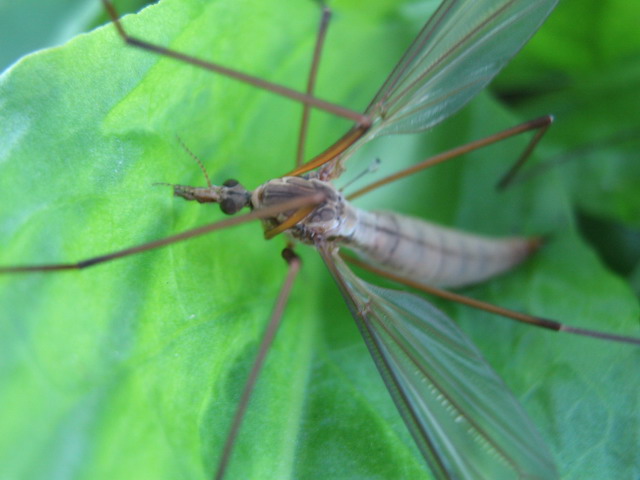Diptera.info :: Identification queries :: Diptera (adults)
Who is here? 1 guest(s)
|
Which Tipula sp could I take?
|
|
| eguzki |
Posted on 19-10-2006 23:32
|
|
Member Location: Perkáta, Hungary Posts: 1140 Joined: 12.10.06 |
Found in our garden among sorrel leaves. I have not better picture, sorry.
eguzki attached the following image:  [68.82Kb] |
|
|
|
| Robert Nash |
Posted on 23-10-2006 14:29
|
|
Member Location: Ulster Museum, Belfast, Ireland Posts: 288 Joined: 11.11.05 |
Expert confirmation is needed but this looks like Tipula paludosa to me : eye separation is quite broad, several times the width of the basal antennal segment. In the very similar Tipula oleracea the area between the eyes is very narrow, only as wide as the width of the basal antennal segment. Wings of female T. paludosa are shorter than the abdomen (can't be assessed here.Wings of female T. oleracea are clearly longer than the abdomen. Phallic (genitalia) characters are different between the two confirming that there are two (sister) species.. Tipula paludosa and T. oleraceaare extremely similar biologically. Tipula paludosa completes a single generation annually, with adult emergence beginning in late August, and their numbers peaking in September and continuing into October. Tipula oleracea, on the other hand, completes two generations annually, with adult emergence in the spring (late May to July) and again in the Autumn (mid August to late September or October) Both species are turf and pasture pests. Tipula paludosa is probably the most injurious and widespread crane fly in northern Europe. Slainte Robert Edited by Robert Nash on 23-10-2006 14:37 |
| eguzki |
Posted on 23-10-2006 21:45
|
|
Member Location: Perkáta, Hungary Posts: 1140 Joined: 12.10.06 |
Robert Nash wrote: Expert confirmation is needed but this looks like Tipula paludosa to me : eye separation is quite broad, several times the width of the basal antennal segment. In the very similar Tipula oleracea the area between the eyes is very narrow, only as wide as the width of the basal antennal segment. Wings of female T. paludosa are shorter than the abdomen (can't be assessed here.Wings of female T. oleracea are clearly longer than the abdomen. Phallic (genitalia) characters are different between the two confirming that there are two (sister) species.. Tipula paludosa and T. oleraceaare extremely similar biologically. Tipula paludosa completes a single generation annually, with adult emergence beginning in late August, and their numbers peaking in September and continuing into October. Tipula oleracea, on the other hand, completes two generations annually, with adult emergence in the spring (late May to July) and again in the Autumn (mid August to late September or October) Both species are turf and pasture pests. Tipula paludosa is probably the most injurious and widespread crane fly in northern Europe. Slainte Robert Hi Robert! It was a pleasure to read your comprehensive text! Thank you again and again... Greetings! |
|
|
|
| Jump to Forum: |













